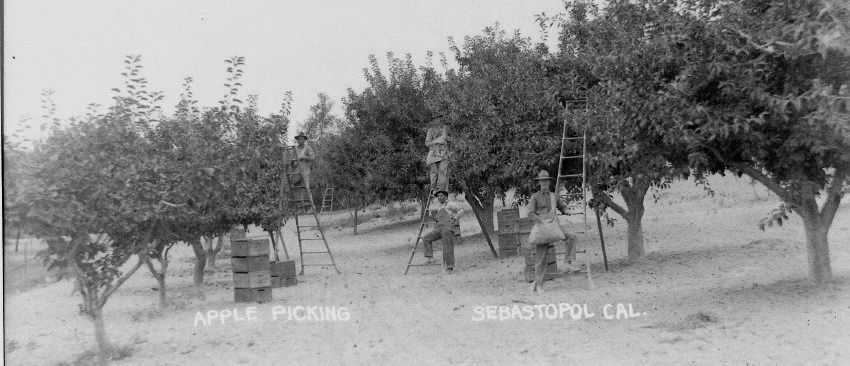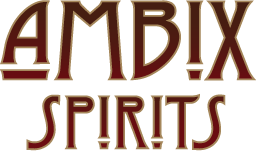In today’s newsletter deep dive we take a moment to reflect on local history and those who paved the way for us to do what we do. This is a rich topic with many rabbit holes to explore and we will certainly revisit it in the future, but today we start with an overview.

A Brief History of Sebastopol Brandy
Sebastopol Apples
Apples were the fruit and cider was the drink of the European settlers and so any early settlements in what is now Sonoma County included apple orchards. Our famous Gravenstein apple came to Sonoma County as part of the orchard of the Russian settlement of Fort Ross of 1811.
Local industrial scale apple orchards in Sonoma County started in the 1850’s with Mitchell Gilliam’s orchard in Graton and 30 years later Natheniel Griffith who, with the encouragement of Luther Burbank, started growing Gravenstein apples in his orchard and put history is motion.
By 1910 the local apple harvest had surpassed 100,000 tons and the first Sebastopol Gravenstein Apple Show was held (the forerunner to the Apple Fair of today). Apples that could not be sold for fresh eating would be dried or processed into products such as cider, vinegar and of course apple brandy.

Pre-Prohibition
Making brandy is simply a way to preserve the value of produce into a product that can be held for years. So, where there is fruit being grown brandy distilleries will soon appear.
The first licensed distillery in the US was an apple brandy distillery. Laird and Company which is still in business today and owned by the Laird family, traces its history back to Alexander Laird who emigrated from Scotland and started distilling apple brandy in New Jersey in the early 1700’s. Apple brandy was widely produced in colonial America and local distillers ensure made sure that left over fruit from the orchards was put to good use.
In our research we have found several pre-prohibition distilleries in Sonoma county producing brandy from wine grapes but have not yet found details on pre-prohibition apple brandy other that some warehouse records. We are still on the hunt and if you have any clues please let us know!
Some notable and interesting early distilleries of our area include if you have others that you know of please let us know!
Jacob Gundlach – One of the earliest records we found and still lives on today as Gundlach Bundschu. Gundlach first started producing brandy in Sonoma in 1859.
Valley of the Moon – A 60-acre vineyard planted by George Whitman in 1863 that was producing over 2,000 gallons of brandy by the late 1860’s. Notably later purchased by Senator George Hurst
Alexander Calder – an early settler who developed a distillery in 1874 at what is now Ives park near downtown Sebastopol.
Asti – An Italian Swiss Agriculture Colony was formed in 1881 just south of Cloverdale, produced many brandies and for a time was the 2nd largest tourist attraction in California.
Korbel – The Korbel brothers started making brandy in 1889 near Guerneville in an iconic stone tower. The brand is still going strong today.

Prohibition
While prohibition shut down legal distilling operations it fueled a network of clandestine distilleries throughout Sonoma.
The premium product during prohibition was jackass brandy made from a combination of fermented grapes, raisins or other fruit with sugar added to bump up the alcohol. Often distilled in valleys it would be transported out by donkeys. Of course, the facilities were not documented except for newspaper accounts of busts. I’ve not yet found good evidence of prohibition era apple brandy spirits in Sonoma but there is a rich history of illicit distilling throughout Sonoma County.
One of the most sensational raids was by District Attorney Jock Pemberton who raided the Kawana Springs Resort which at the time was a long-shuttered hotel near Taylor Mountain in Santa Rosa. Bootleggers had gutted the hotel and put in a three stills, the largest of which was capable of producing over 1,400 gallons of ethanol a day.
Another notable raid shortly thereafter that hits closer to home was of Joe Garayalde who had hundreds of gallons of jackass brandy as well as wine and sugar at a facility on the Laguna de Santa Rosa at Guerneville Road, just a few miles north of our facility.
At its peak as much as a thousand gallons of jackass brandy was being dumped into Laguna de Santa Rosa a month which has us wondering how much more was being produced. Afterall when you have a large wine grape and apple area deprived of its ability to produce cider or wine, it does make sense that distilling it down to a more concentrated and stable distillate might have made Prohibition the peak of Sonoma County brandy production

Speas Distillery
The largest legal apple brandy distillery of Sonoma County was in what is now Sebastopol’s Barlow Market. While the distillery itself is gone the barrel aging building lives on in a new life as the Rialto Cinema. Above is a picture from the inside Rialto when it held thousands of barrels of apple brandy
The Sebastopol facility was originally built as a vinegar plant in 1919 and then purchased by the Speas Company in 1929. Post prohibition they build a 5-story structure to house a 2,000 gallon column still. At their peak Speas made up to 600 barrels of apple brandy a year Eventually they also started producing “Apple Wine” which was a sweet cider fortified with apple brandy, effectively the same type of product as our Cider Royal. It was popular during the war as it was a sweet but high alcohol product that was stable and could ship around the world without refrigeration.
Speas ran strong as an apple brandy distillery shipping throughout the country for many decades until 1971 when the owner passed away. After his death the company suffered and eventually was sold. The distillery list its fires for the last time in 1979.
I have on a few occasions had a customer come in and share memories of the Speas distillery and it’s great to make the connection to the past and try to establish our own small place in the long history of apple brandy history
Further Reading
Press Democrat, Early Apple Industry Pioneers in Sonoma County

